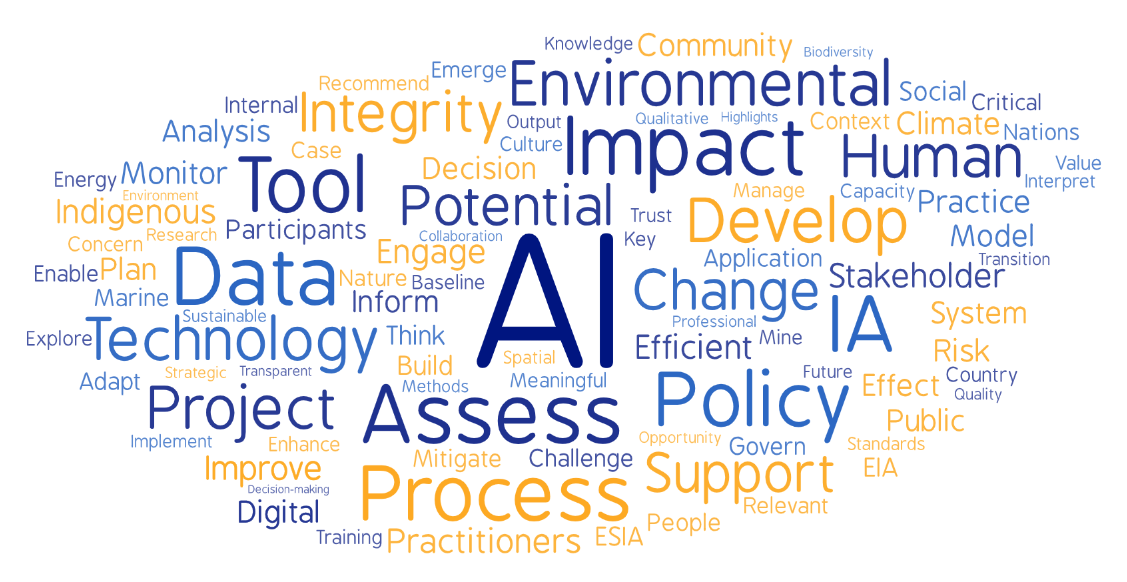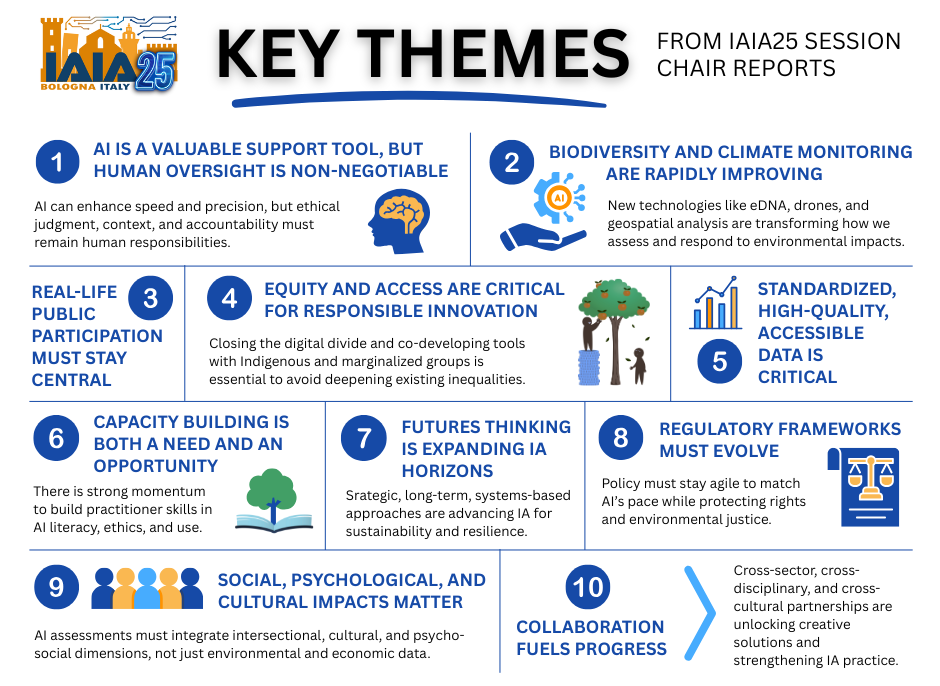Mapping a journey from IAIA25 to IAIA26
Reflections from IAIA CEO Gary Baker
It has been encouraging to read the excellent summaries that have emerged from various conference participants, drawing their conclusions from the rich content presented in Bologna at IAIA25.
This commentary is, on one level, simply adding further material on the topic, but there are no apologies for that: the future of AI is deserving of as much scrutiny as we can provide.
But I also wanted to approach this as a meta-analysis in trying to draw conclusions from the conclusions, and by doing so, help to map a course towards IAIA26 in Québec City. It doesn’t require a gym-trained LLM to draw a very clear line connecting Bologna's Impact Assessment in the Age of AI with the IAIA26 theme of Misinformation, Disinformation, Communication, & Impact Assessment.
A straightforward word cloud of the most frequent terms contained within the IAIA25 session chair reports surfaces all the raw materials we would expect to see from the conference theme:

Taking this a few steps forward, in poring through the IAIA25 session chair reports, perhaps predictably, I used ChatGPT to perform a task it really does excel in, namely, blindingly quick, accurate summaries of a large data set. The conclusions from this are provided in the illustration below listing the top ten key themes emerging from the session reports.
These provide a good, balanced view of proceedings in acknowledging the benefits, both potential and already operational, of AI: the critical importance of high quality, ethical, equitable data sets; the utility of AI as a support tool; and an emphasis on the still-vital requirement for deep human involvement within the IA process. In trade parlance, they describe human-in-the-loop design. Session conclusions repeatedly point towards a hybrid system of HI-AI (human-artificial) collaboration in delivering a future-proofed Impact Assessment capability. And finally, there was a strong plea for training resources to build practitioner skills in AI literacy, ethics, and use of AI (more to come on this in coming months).

But, in addition to presenting a ‘neutral’ interpretation of the summaries, I was also interested in using ChatGPT to offer an ‘optimistic’ summary of the same information. The intention here was to re-weight the balance to emphasize achievements already being seen and to point to upside potential, with less qualification.
- AI is Enhancing Efficiency and Accuracy
– From document reviews to geospatial analysis, AI is streamlining workflows and improving decision-making.
- Biodiversity Monitoring is Advancing Rapidly
– Innovative tools like eDNA, drones, and bioacoustics are enabling real-time, non-intrusive ecosystem tracking.
- Growing Integration of Traditional Knowledge
– Some efforts are emerging to co-develop tools with Indigenous communities, recognizing their leadership and sovereignty.
- Increased Awareness of Equity and Inclusion
– Sessions highlighted the importance of data equity, cultural relevance, and avoiding exclusionary practices.
- Interdisciplinary Collaboration is Gaining Ground
– Practitioners are working across disciplines—social science, data science, environmental science—to improve IA quality.
- Futures Thinking and Strategic Planning Are Expanding
– More emphasis is being placed on long-term, systems-based thinking, including intergenerational equity and climate resilience.
- Capacity Building is a Shared Priority
– There’s a strong commitment to training, digital literacy, and knowledge-sharing, especially in the Global South.
- Marine and Climate Assessments Are Growing More Sophisticated
– Sessions showed expanded use of AI and data modelling in marine spatial planning, climate risk prediction, and adaptation strategies.
- Tools Are Becoming More Accessible and Scalable
– Examples from multilateral banks and regional hubs show how AI can help organizations of all sizes work smarter, not harder.
- AI is Being Used to Support—not Replace—Public Participation
– Responsible applications of AI are helping communities engage more meaningfully, not sidelining them.
It is the same information that lists very similar considerations (treatment of traditional knowledge, support-not-replace, importance of public participation…), but it suggests that these challenges are addressable and that positive progress is being made. Once again it points to a hybrid future state, where humans can embrace the strengths and recognise the weaknesses of AI.
And this is where I would draw the line towards IAIA26 in Québec City. Much of what we saw in Bologna comprised an initial ‘kicking of the tires’ in figuring out how to utilise/ experiment with AI, how to understand the user feedback thus far, and to identify and address shortcomings (of which there are many). But I am excited to think how much further along we might be in 12 months’ time given the pace of system and agentic development, and the additional evidence gained from cumulative experience in building on our ingenuity, cross-disciplinary inquiry, and common sense—our essential, human, emotional (spiritual?) core that keynote speaker Federico Faggin so wonderfully explained is not, and will never be, machine programmable.
Roll on Québec City.
